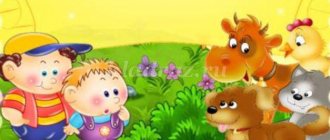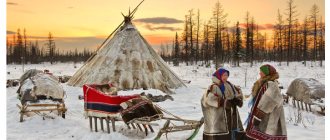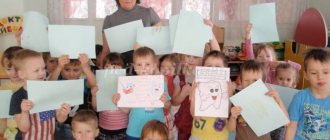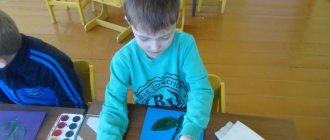Project “Cartoons by children’s hands”
Project
"Cartoons by children's hands"
Educator:
Simonova Tatyana Ivanovna
Children's age: 4-5 years
Project type:
creative-cognitive, group
.
Project implementation period: long-term (2019-2020 academic year)
Contents of the OO Federal State Educational Standards for Education: cognitive and creative development.
Relevance of the project. Formulation of the problem.
From the experience of teachers of preschool educational institutions, it is well known that respect for the child’s personality, acceptance of his goals, requests, interests, creation of conditions for self-determination and self-realization actively develops creativity. Protected from the violent interference of others, the life activity of children is manifested in unique forms of play, fairy tales, travel, adventure, and experimentation. Project activities make it possible to implement the principle of an optimal relationship between development determined by the actions of an adult and self-development determined by the child’s own activity
Creating a cartoon with preschool children is a modern type of project activity that is very attractive to children. By carrying out this type of project activity, we support any desire of children for creativity, we have the maximum possible influence on the formation in each of them of a free creative personality, a creative person, as the most expensive and sought-after “product” of education in modern society.
Analysis of psychological and pedagogical approaches to the process of organizing preschool education and training in the light of the implementation of the Federal State Educational Standard, observations of secondary group students during educational activities showed an insufficient level of development of children’s creativity and, in connection with this, the need to use new integrative technologies in the pedagogical process, focused on the child’s personality, on the development of his creative abilities. One of these technologies is the creation of cartoons with children.
Objective of the project:
updating the pedagogical process aimed at creating optimal conditions for the development of creative abilities of preschoolers through the creation of cartoons.
Project objectives:
To form in children a basic understanding of the mysteries of animation.
Introduce the professions: screenwriter, animator, camera operator, editor.
Enrich children's vocabulary with the concepts: “filming, script, frame.”
Develop cognitive, artistic and aesthetic interest in creating cartoons.
To develop proactive creativity and the child’s ability to solve any issues in a non-standard way.
Develop creative thinking and imagination.
Project on the topic “How cartoons are created.”
Cartoons are an amazing and beautiful world that comes to life on the screen. Drawn and puppet characters behave as if they were alive. Incredible miracles happen to them. There is no child in the world who does not love cartoons. I love them very much too. I've watched a lot of cartoons in my life. And I thought: what is a cartoon? How to create it?
The word "cartoon" has different meanings based on different forms of visual art and illustration. In the explanatory dictionary, I read that cartoons, “cartoon, animated film, animation” is a type of cinematic art, the works of which are created by filming successive phases of the movement of drawn (graphic or hand-drawn animation) or three-dimensional objects.
The purpose of my research: creating my own cartoon.
Research hypothesis: I assumed that making a cartoon is simple: once and done.
To achieve the goal, I needed to solve the following tasks:
- Study history.
- Learn basic technologies.
- Conduct a survey among classmates.
- Create your own cartoon.
Object of study: animation as a special type of cinematic art.
Subject of research: the process of creating an animated film.
In my work I used the following methods:
- Studying literature.
- Watching videos.
- Study and analysis of the simplest animation technologies.
- Shooting your own cartoon.
- Analysis of the obtained result.
Animation is the artificial representation of movement in film, television or computer graphics through the display of a sequence of drawings or frames at a frequency that ensures a holistic visual perception of images.
Animation, unlike video, which uses continuous motion, uses many individual drawings.
Synonym for the word "animation" - «
animation
"
is very widespread in our country.
The term animation originates from the Latin word “multi” - a lot and corresponds to the traditional technology of reproduction of a picture, because in order for the hero to “live”, you need to repeat his movement many times: from 10 to 30 frames per second.
Internationally accepted professional definition «
animation
"
(translated from Latin "anima" - soul, "animation" - revival, animation) more accurately reflects all the modern technical and artistic capabilities of animated cinema.
Even in the past, man tried to capture movement in his art.
One of the first examples is rock art from the Chauvet Cave in France.
In ancient Egypt, as early as 2000 BC, people also tried to capture movement with the help of drawings.
In the 70s BC. The Roman poet and philosopher Lucretius, in his treatise “On the Nature of Things,” described a device for displaying moving pictures on a screen.
In the 15th century, books with drawings appeared that reproduced the different movements of the human figure. Rolled up and then instantly unfolded, these books created the illusion of “living” drawings.
Magic lanterns, or laterna magica in Latin, were popular in the Middle Ages. These are optical devices into which transparent plates with drawings were inserted - creating the illusion of moving pictures.
The history of animation begins at the end of the 19th century. On July 20, 1877, in the city of Anesse, the self-taught French engineer Emile Reynaud created a unique apparatus called the praxinoscope. With the help of this device, Emil Reynaud created and showed short cartoons from 5 to 15 minutes. The French city of Annecy is considered to be the birthplace of hand-drawn animation. In 1977, Annecy celebrated the 100th anniversary of animation.
Reynaud's services to animation can hardly be overestimated, but he cannot be called the creator of the first cartoon in history, because... No film was used in the production of his films. However, in honor of Renaud's first show of "luminous pantomimes" in Paris to the general public in 1892, October 28 has been celebrated as International Animation Day since 2002.
In America, in 1906, John Blackton shot the first cartoon with the first movie camera. The first cartoons were black and white and silent.
Hollywood actor Walt Disney, an animator, film director, actor, screenwriter and producer, made a great contribution to the development of world animation. He is the creator of the first sound, first musical and first full-length cartoon in history - “Steamboat Wiley”.
From 1930 to the present, his cartoons have been extremely popular.
Animation also has a long history in our country. In 1910, Vladislav Aleksandrovich Starevich shot the world’s first three-dimensional animated film, “Beautiful Lyukanida, or the war of the stags with the barbels.” The film lasted 10.5 minutes and the “actors” in the cartoon were various insects.
In 1936, the Soyuzmultfilm animation studio was organized in our country. Over the more than 70-year history of animation, the studio has created the well-known cartoons “Well, wait a minute!”, “Baby and Carlson”, “Winnie the Pooh”, “Three from Prostokvashino”, “Crocodile Gena”, etc.
Currently in Russia there are several large animation studios and many small ones. The most famous are the studios “Pilot”, “Melnitsa” and “Animaccord”.
In order to accurately determine what kind of cartoon I will create, I became acquainted with the classification of cartoons.
Cartoons are divided by country of origin:
- American (Walt Disney cartoons);
- French (for example, “Lady Bug and Super Cat”);
- Japanese (anime) (“LVH” Battles of the Little Giants”);
- Russia (USSR) (“Just a minute!”, “Masha and the Bear”);
- Italian (“Egyptus”, “Winx Fairies”);
- English (“The Amazing World of Gumball”).
By purpose:
- educational;
- developing;
- educational;
- educational;
- entertaining;
By duration:
- short films (lasting up to 45 minutes);
- full-length (over 45 minutes).
By age interests:
- for children;
- for teenagers (anime);
- for adults.
By technological process:
- drawn.
- computer.
- puppet
- plasticine.
- sand
- appliqué
Now I know that my cartoon will be short, children's, entertaining and applique. I decided to create it using modern computer programs.
I decided to investigate whether my classmates liked cartoons and conducted a survey among students in grade 1 “B”. 31 people took part in the survey.
Analysis of the questionnaires showed that all students 100% love watching cartoons.
52% love any cartoons, both foreign and domestic. 16% prefer foreign cartoons. And 32% are domestic cartoons. I showed all this in the form of diagrams.
To the question, “Why do you love cartoons?” were named: funny - 39%, interesting - 23%, kind - 19%, bright - 19%.
3. Among domestic cartoons, cartoons are most often named as favorites: “The Fixies” - 21%, “Fairytale Patrol” - 14%, “Masha and the Bear” - 9%. Among foreign ones - “Gravity Falls” - 24%, “Lady Bug and Super Cat” - 17%, “My Little Pony” - 6%. Among others, children also mentioned the cartoons “Smeshariki”, “Teenage Mutant Ninja Turtles”, “Zach Storm - Legend of the Seven Seas”, “Super Four”.
Children spend a lot of time watching cartoons, this can be seen from the survey results: 55% of children watch cartoons every day, sometimes - 32%, rarely - 10%, on weekends - 3%.
Thus, I concluded that most children prefer cartoons according to their taste. The most favorite cartoons are “The Fixies,” a Russian cartoon, and a foreign cartoon, “Gravity Falls.”
To learn all the intricacies of the animation business, I visited the Children's Animation Studio "MultSOL".
Children's animation studio "MultSOL" was created in 2015, at the center for children's additional education "Virazh". The head of the studio, Natalya Valerievna Filipeva, told me all the secrets of creating cartoons.
The studio is equipped with technical equipment: a camera, lighting devices, a cartoon machine, a computer with an editing program. There is also everything for creating backgrounds, decorations and main cartoon characters.
Cartoons can be created in different techniques:
- Paper animation - creating paper characters, transferring, cutting out characters from paper, moving them on a plane;
- Plasticine animation - characters are molded from plasticine, they can be either flat (in which case the technique is close to transference) or three-dimensional (in this case the technique is close to puppet animation);
- Subject animation (cubes, construction sets, cars, trains, animals and people);
- Bulk animation (not only sand, but also all sorts of cereals, beads, coffee, etc., etc.);
- Pixelation (the main actors are children themselves).
At the studio, every child will be able to come up with a script for their own cartoon, choose an animation technique, create and voice characters, and even make cartoons themselves. But before filming a cartoon, complex and time-consuming preliminary work has to be done.
The first stage is creating a cartoon script.
Screenwriting is an art. Any cartoon is a story about something. First they make a sketch: where, when and what will happen? Who are the heroes? How do they interact with each other? What is their character? Where does the action take place: indoors, outdoors? What do the heroes do? When the outline is ready, the story is written in the order in which it will develop. The main thing in the script is action and dialogue.
Stage two - storyboard
- this is your cartoon in drawings. It looks like a comic book. Draw the actions taking place in the scenario using special squares (they can be drawn by hand). With the help of a storyboard, you can clearly imagine what the cartoon will look like.
The third stage is the creation of characters, backgrounds and decorations
. First, they sketch the characters on paper. If the image of the heroes is invented, they sculpt, draw, cut out. All the details of the character’s body must be sculpted separately - after all, in the process of “revitalizing” the hero, his body parts must move.
Then we create the cartoon background. They take an A3 sheet of paper, place it on top of their hero, and then, matching the sizes, draw the background. You need to make sure that the bird is not larger than the tree (unless this is planned according to the cartoon script). The background can be drawn with pencils, felt-tip pens, paints or even plasticine.
Important! There should be no moving objects drawn on the background. For example, birds. They need to be made separately and moved during the filming of the cartoon.
Decorations are the decorations of your background. If you have the sky in the background, it would be great to sculpt or draw and cut out the clouds separately.
The fourth stage is filming.
Here you will need: a camera and a cartoon machine. We attach the background to the cartoon machine on the lower tier and add the necessary decorations. Heroes will move on the upper tier. Next, we set up the camera so that the image is bright and clear. Then they begin to revive the characters, according to the script. It is very important to move the characters slowly, no more than 1 cm, in each frame. And so we “move and photograph” to our destination. This process is called animation. "Anima" is translated from Latin as "soul". Therefore, the process of animation is animation. Our plasticine cat becomes alive on the screen.
The fifth stage is editing the footage and dubbing.
On your computer, download the editing program Windows Movie Maker or SONY VEGAS. To create 1 second of a cartoon, you need 24 frames, and to shoot a 1-minute cartoon, at least 300 frames.
We upload our photos in order, record voice acting, music, sounds, and add them to the video sequence. And we get a cartoon!
Children's cartoons created by students of the animation studio are winners of municipal, regional, all-Russian and international competitions.
Animation is a very interesting, rich history, constantly evolving form of modern art. During the research process, I learned a lot about animation and realized that shooting your own cartoon is an interesting and challenging activity.
It's not an easy job to make cartoons!
In the process of work, I realized that my hypothesis was not confirmed. Watching cartoons is easy, but making them is not easy.
Now I know exactly what a cartoon is! Cartoon is the hard work of many people, their creativity and imagination. Cartoons take a lot of time, but at the same time it is a very interesting activity!
Now, watching even a short cartoon, I understand that a lot of work was done there by a whole team of people.
In the future, I am faced with the task of learning how to make smooth frame transitions and more rich and interesting cartoons.
Bibliography
1. Asenin S. Wizards of the Screen - M., “Iskusstvo”, 1974. – 145 p.
2. Large encyclopedic dictionary. M.: scientific. publication "Big Russian Encyclopedia", 1998, p. 1434
3. I. Vano “Drawn Film” (book on the Internet)
4. Hamburg E., Pekar V.. Artists of animated drawing, Union of Cinematographers of the USSR, 1984.
5. Ozhegov S.I. and Shvedova N.Yu. Explanatory dictionary of the Russian language. M., LLC "ITI Technologies", 2003. - 944 pp.
6. Simon M. How to create your own cartoon - NT Press, 2006.- 337 p.
7. Internet sites:
https://ru.wikipedia.org/wiki/Cartoon
https://ru.wikipedia.org/wiki/Plasticine_animation
https://ecorucheyok.ru/pedagogicheskaya-kopilka/multfilm-svoimi-rukami-v-proekte-bumazhnyj-akvarium.html






